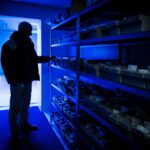
Warning signs on Opal Fields near Coober Pedy in outback South Australia. Image: Ashley Whitworth/Shutterstock
Australia is a country rich in minerals; there are literally billions of dollars beneath our feet — and we keep stepping on them because we simply don’t have the tools to reach them. Mining in general and especially in Australia occurs on a boom and bust cycle. Someone finds a mineral deposit and mines it (boom) until there is none of it left (bust). Australia’s mining industry has already extracted or is in the process of mining the easy-to-reach deposits but we are yet to tackle the wealth of deposits that lay deep beneath our land mass. The Australian mining industry is also facing the new challenge of creating “˜greener’ mining techniques that not only reduce the carbon dioxide output but also minimise damage to the environment.
The answers to these problems are in research and design: there is a strong demand for new technology that reaches further into the earth, which is faster, cleaner and more efficient. The marriage between academic research and industry funding is an extremely important bond for both parties. Industry funding allows academic research to take shape and continue to grow while the industry reaps the benefits of the results. This is particularly true of technology, which has an ever-increasing demand for new and more complex systems that’s becoming important in a vast and diverse range of fields.
The need for new technology is particularly apparent in the mining industry where the need for exploration is propelled further by the need for cleaner machines. Rio Tinto has invested heavily in academic research for this reason and in 2007 teamed up with the Australian Centre for Field Robotics (ACRF) at the University of Sydney to create the Rio Tinto Centre for Mine Automation (RTCMA). Rio Tinto injected 21 million dollars into the project making it the largest “˜civilian’ robotics research. The aim of the centre is to create mines that are fully automated — robots doing the manual labour and people operating them from hundreds of kilometres away. The centre combines industry and academic engineers from around the world focusing on sensing, machine learning, artificial intelligence and system engineering.
The RTCMA comes under Rio Tinto’s “˜Mine the Future’ programme. The aim of the program is to develop new technology that increases efficiency, health and safety, decreases costs and environmental impact and creates better working conditions for the workers. As a part of “˜Mine the Future’ Rio Tinto is also working with the Imperial College of London to create faster tunnelling and more precise metal recovery. Along with the University of Sydney, Rio Tinto have also invested with the University of Queensland to create the Rio Tinto Centre for Advanced Mineral Sorting and with Curtin University to create the Rio Tinto Centre for Materials and Sensing in Mining.
In late 2008, Rio Tinto put some of their technology to the test in Western Australia. This “˜prototype mine’ has an autonomous drill rig platform, a semi-autonomous smart explosive loading and autonomous haul trucks. Workers operated these machines over a thousand kilometres away from the Operations Centre in Perth.
No hands on the wheel – Autonomous haul trucks
In November 2011 Rio Tinto purchased 150 FrontRunner driverless trucks from Komatsu Limited. This purchase was a dramatic increase from their fleet of ten trucks (which they were testing in the A Pit mine) and also makes it the largest fleet in the world. The trucks, which are due to arrive in early 2012 will be put to work at the Pilbara iron ore mines in Western Australian. The trucks use artificial intelligence to learn the layout of the mine, enabling trucks to recognise potential obstacles and avoid them as well as preventing vehicle crashes. All this is done by the obstacle prevention system. High precision GPS is able to precisely locate the truck and calculate the quickest route — cutting down on time and fuel consumption. The trucks are operating via a wireless network system with workers monitoring the progress form their operation centre thousands of kilometres away.
Drilling the point in
Automating industrial machinery is nothing new to the ACRF, which as a part of the RTCMA has created autonomous drills. The drills, which Rio Tino are now trialling, use advanced navigation to determine the most precise point for drilling. Not only do they drill but they simultaneously analyse the rocks as they drill to determine the most appropriate spot for explosives to be deposited. The rock analysis results feed into a mapping system that creates a 3D picture of the rock and the mineral deposit, which they are trying to reach, further aiding in the navigation. Autonomous drills, especially ones such as these make the drilling process more refined with less time spent estimating and more time spent drilling. Autonomous drills (not necessarily Rio Tinto’s) also have broader applications in space exploration, where human operated drills are not a practical option. In 2006 NASA tested automated drills in Canada as a part of their Drilling Automation for Mars Exploration (DAME) project, with hopes that their fully automated drills will one day being boring into the surface of Mars.






